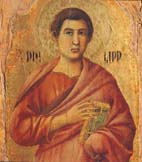| JUBILEE PHILIP AND SIMON A Greek and a Zealot in the Shadow of Jesus Philip, Witness to the Multiplication of the Bread and Fishes A man of high social status and culture who eventually suffered martyrdom. His bones now lie beneath the high altar of the Basilica of the Holy Apostles (Santi Apostoli) in Rome BY ALESSANDRO ZANGRANDO |
|
He was an apostle
very close to Jesus, full of curiosity and willingness to risk, who
said what others were afraid to say. Philip, too, came from Bethsaida,
in Galilee, the town of the fishermen who left their nets to follow
the Messiah, like Peter, Andrew, and James. The Gospels of Matthew,
Mark, and Luke mention him only once, in the list of the apostles,
naming him fifth, before Bartholomew. We find a little more information
in John. Jesus called together his first disciples and "after Jesus
had decided to leave for Galilee, he met Philip and said, 'Follow
me.'" (Jn 1:43) Philip accepted the invitation, with a "yes"
full of conviction and enthusiasm. Immediately afterward he met Nathanael,
who is identified as the apostle Bartholomew. Wasting no time, he
shared his happiness with him: "We have found Him of whom Moses in
the Law and the prophets wrote, Jesus son of Joseph, from Nazareth."
Nathanael was suspicious. But Philip did not try to convince him,
nor did he give him any more details about the son of Joseph. He simply
proposed to Nathanael: "Come and see." Nathanael went and saw, and
after he saw his life too was changed in an instant. (Jn 1:45-51) |
|
| Simon, the Revolutionary who Humbly Followed the Messiah He belonged to the Zealots, intransigent protesters against the Roman power. Very little is known about him. His relics are venerated beneath the Altar of the Crucifixion in St. Peter's BY GIUSEPPE FRANGI |
|
To know Simon,
one has to begin by knowing his nicknames: the Gospels call him the
"Cananean" (in Mark and Matthew) or the "Zealot" (in Luke, as well
as in the Acts). For a long time it was thought that Mark and Matthew
referred to his origins in Cana in Galilee, the village where Jesus
performed his first miracle. Some ancient sources even thought that
Simon was the bridegroom at that wedding. Then research into the meaning
of his nickname put things back in place. Cananean comes from the
Aramaic "qen'ana'," which means zealous, or maybe Zealot. Here, then,
the three synoptic Gospels agree about the figure of Simon; he was
a zealous apostle with respect to Jewish law and traditions. But some
suggest anotherpossibility: couldn't his name mean that Simon belonged
to the Zealots? |

